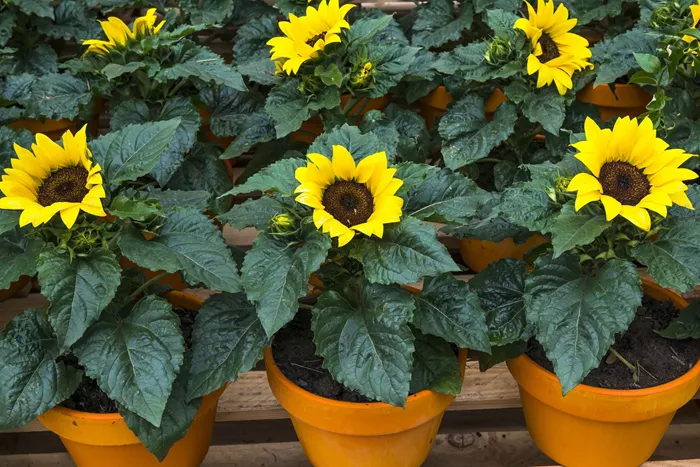Sunflowers are one of the most beautiful and easy-to-grow flowers, making them a popular choice for gardens. They can brighten up any space with their tall stems and large, vibrant blooms. Whether you’re an experienced gardener or just starting out, growing sunflowers can be an enjoyable experience. In this article, we’ll guide you through everything you need to know to grow sunflowers successfully. From choosing the right seeds to ensuring they get the proper care, you’ll be on your way to having your own sunflower-filled garden.
Choosing the Right Type of Sunflower
Before you begin planting, it’s important to decide which variety of sunflower you want to grow. There are different types, ranging from giant sunflowers that can grow over 10 feet tall to smaller dwarf varieties that are ideal for smaller gardens or containers. Some sunflowers are grown primarily for their seeds, while others are valued for their ornamental beauty. Research different varieties to find one that suits your space and needs.
Soil and Location
Sunflowers thrive in well-drained soil, so it’s essential to choose a spot in your garden with good drainage. The soil should be loamy, rich in organic matter, and slightly acidic to neutral in pH. A soil test can help you determine the pH of your soil. Sunflowers need full sun to grow properly, so make sure to plant them in a spot where they will receive at least six hours of direct sunlight each day.
Planting Sunflower Seeds
The best time to plant sunflowers is in the spring, once the soil has warmed up. Sunflower seeds should be planted about 1 to 2 inches deep into the soil, with a spacing of 6 to 12 inches between each seed. For larger varieties, give them plenty of space to grow, as they can reach up to 12 feet tall. If you’re planting multiple sunflowers, leave ample room between them to prevent overcrowding.
Watering Sunflowers
Watering is a crucial part of sunflower care. After planting, water the seeds thoroughly to help them germinate. Once your sunflowers are established, they will need about 1 to 1.5 inches of water per week. During dry spells, you may need to water them more often. However, be cautious not to overwater, as sunflowers don’t like to sit in soggy soil. Consistent watering will ensure healthy, strong growth.
Fertilizing Sunflowers
Sunflowers are heavy feeders, meaning they benefit from regular fertilization. Use a balanced, slow-release fertilizer to promote strong root development and healthy growth. A good time to fertilize is when the plants are about 12 inches tall and again when they start to bloom. Organic fertilizers like compost or manure can also be used, providing the plants with the necessary nutrients without overloading them with chemicals.
Staking and Supporting
As sunflowers grow tall, they can become top-heavy and may need support to keep from falling over. Depending on the variety, some sunflowers may need stakes to support their stems. Drive a stake into the soil near the base of the plant and tie the sunflower to it with soft twine. This will help the plant remain upright, especially during windy weather or when it starts to bloom.
Pests and Diseases to Watch Out For
While sunflowers are relatively easy to grow, they are still susceptible to certain pests and diseases. Aphids, caterpillars, and birds can damage the flowers and seeds. To prevent this, check your plants regularly for signs of pests. You can use insecticidal soap or neem oil to get rid of unwanted insects. Additionally, powdery mildew and fungal infections can affect sunflowers, so be sure to water them at the base to keep the leaves dry and improve air circulation around the plants.
Harvesting Sunflowers
Sunflowers can be harvested once the petals start to droop, and the backs of the heads turn yellow. If you are harvesting sunflowers for their seeds, wait until the seed heads are fully mature and the seeds are firm. To remove the seeds, simply cut off the flower head and rub the seeds out by hand. If you’re harvesting sunflowers for their decorative beauty, cut the stems when the blooms are in full color, and enjoy them in a vase.
Common Challenges When Growing Sunflowers
Though sunflowers are generally easy to grow, there are some common challenges that gardeners might face. These include dealing with pests, weather-related problems, or soil issues. However, with the right care and attention, you can overcome these obstacles and enjoy a garden full of tall, colorful sunflowers.
Conclusion
Growing sunflowers can be a fun and rewarding experience. By selecting the right variety, providing the proper care, and staying vigilant against pests, you can enjoy the beauty of sunflowers in your garden all summer long. Whether you choose to grow them for their striking flowers, edible seeds, or both, sunflowers are sure to brighten up any outdoor space.
FAQs About Growing Sunflowers
1. When is the best time to plant sunflower seeds?
The best time to plant sunflower seeds is in late spring when the soil has warmed up to at least 60°F (15°C).
2. How often should I water sunflowers?
Sunflowers need about 1 to 1.5 inches of water per week. Increase watering during dry spells, but avoid overwatering.
3. How much sunlight do sunflowers need?
Sunflowers require full sunlight for at least six hours a day to grow healthy and tall.
4. Can I grow sunflowers in containers?
Yes, dwarf sunflower varieties are perfect for growing in containers. Just ensure the pot is large enough to accommodate the roots.
5. How can I prevent pests from damaging my sunflowers?
Regularly check for pests like aphids or caterpillars and use insecticidal soap or neem oil to control them.


